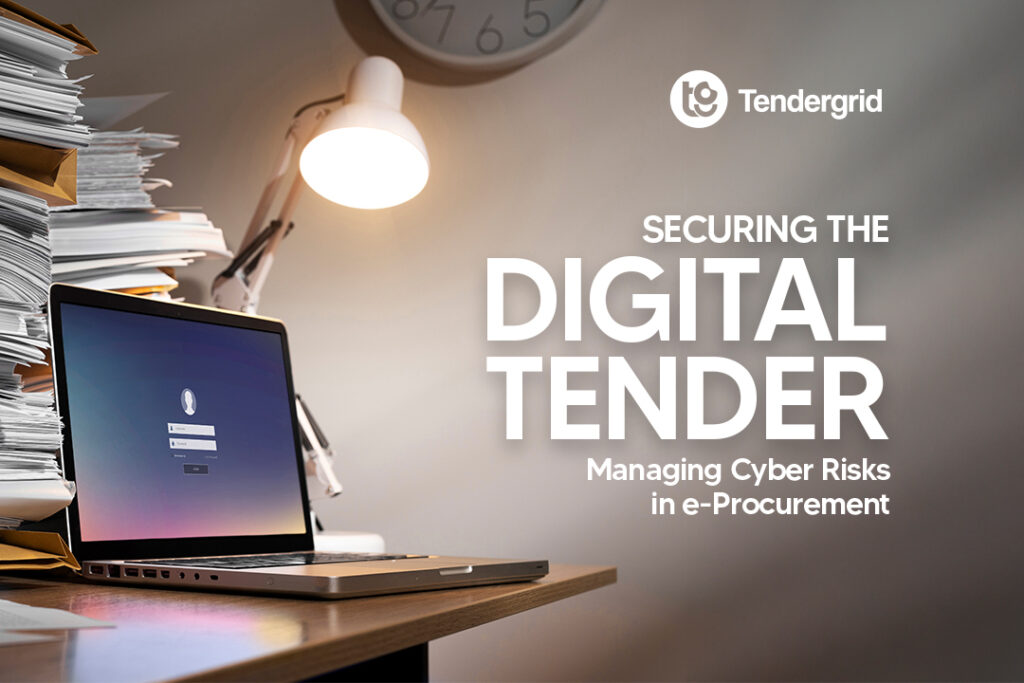Did you know that in April 2025, India’s Ministry of Electronics and IT observed over 21 lakh Cybersecurity incidents over a short span of 3 months. On top, this issue has been faced by various public-facing eProcurement Portals, including government procurement systems too. With tenders worth thousands of crores being handled and operated digitally, digital risks, mainly Cyber threats, have started exploiting authentication, encryption, and access control. A single breach of an eProcurement portal can result in leak or loss of sensitive bid data, delay in projects, or even manipulation of competitive outcomes. This will lead to jeopardised transparency and public trust.
The fact is, this is not just a theoretical risk. Recent cyberattacks on state-run boards as well as municipal portals are clear examples of malicious activities damaging the digital infrastructure for official processes, including tender procurements. While the expansion of digital tenders is not looking back, the question is, till when will these platforms be targeted?
Therefore, proactive Cybersecurity has become a governance necessity, rather than just a technical upgrade.
Understanding Today’s Cyber Threats
Indian cyber-defence agencies like CERT-In and I4C have pointed out numerous risks that are directly targeting e-procurement platforms:
- AI-driven scams and phishing: Attackers are now taking advantage of generative AI to create highly convincing phishing emails that siphon credentials, attacking the core of the system.
- Malware via vendor portals: Compromised supplier systems, which are very common in vendor-operated e-procurement portals, can affect connected portals. This keeps spreading like an infection.
- Interception of communications: If connections do not have end-to-end encryptions, then it can lead to unethical alteration or interception of sensitive bid data.
- DDoS (Distributed Denial of Service) threats: As observed in alleged attacks on UIDAI and DRDO, disturbance during tight submission windows can cause problems for legitimate bidders to participate.
- Credential stuffing: Reused or leaked passwords are used for exploitation at scale. Nearly one third of email threats in India come from reused or leaked credentials.
Five Core Strategies for Safer Digital Tenders
a) Encryption Across the Board
All data (in transit or at rest) must be secured using modern security standards. Also, hosting environments should align with ISO 27001/NIST or any other government specifications.
b) Strict Identity Verification
Implement compulsory multi-factor authentication for all users, whether officers, vendors, or evaluators. Incorporate token-based logins or biometric methods to prevent the system from unauthorised access or malicious risks.
c) Controlled Access and Visibility
Incorporate role-based access controls. Vendors must be able to see only their submissions, evaluators must access only assigned bids, and official teams should only monitor platform health rather than the confidential content.
d) Immutable Audit Logs
Whether submission, download, or change, every action should be automatically registered with timestamps and stored off-site too.
e) Vetting Vendors Before Participation
Add automated KYC workflows using GST/PAN databases, integrate vendor scoreboards, and verify the previous contract performance to prevent malware or shell companies from disturbing the digital tender processes.
Moreover, it is important to understand that technology is just a part of the solution, as human errors like mistrusting wrong emails or ignoring updated prompts are the top factor for tender breaches. Hence, regularly training staff members and vendors can create a positive impact, reducing incident risks.
The current need is to organise monthly refresher sessions on identifying phishing, verifying links, and securing the passwords. Running simulated risks like tabletop drills for quick response should be done regularly to test organisational awareness and responsiveness.
The Role of Purpose-Built e-Procurement Portals
Generic platforms often lack requirements of secure procurements. Also, they fall short on complying with industry or government regulations, managing complex processes, offering audit trails, and enabling seamless collaboration between multiple stakeholders. Whereas purpose-driven e-Procurement portals like Tender Grid built solutions, offering tailored features like:
- Digital signature workflows to authenticate submissions.
- Blockchain system to tamper-evident bidding records.
- Automated compliance aligned with global standards.
These systems not only guide a better workflow, but also unlock scope for audit and breach resilience for sensitive digital tenders.
Regulatory Mandates and Compliance For eProcurement Portals
Indian Procurement Guidelines (under CPPP and MeitY) now include cryptographic requirements, reporting timelines, and various platform security standards. Moreover, breaches like the Mizoram portal defacement triggered immediate action from CERT-In, which resulted in imposed remediation measures and issued directives asking for swift incident-reporting in digital tenders.
Plus, cooperation between CERT-In and U.S. agencies also positively impacted cross-border investigation capabilities. If you are a public sector buyer, then you should ensure that the e-procurement portal provider has complied with these evolving rules to avoid any fines or disqualification.
Real-life Illustrations: Lessons and Takeaways:
a) Mizoram exam portal breach- May 2025
The portal was defaced, though it was restored within just an hour. But it gave us a major lesson; even short outrages can harm confidence during the tender cycles.
b) Global data breach spike- June 2025
In June 2025, major resources like Zoomcar, North Face, and Episource suffered data damage and ransomware. These events indicate the need for localised procurement-focused defences.
Building A Plan for the Future for Digital Tendering
India’s digital procurement ecosystem is all ready for growth. Right from free trade agreements with the UK, EFTA, and Australia to other strategies, it opens the door for global vendors to participate in digital tenders. But the fact can’t be ignored that this also increases the risks, especially where participants may have different regulatory environments.
Meanwhile, threats have been given a push through Generative AI-powered deepfake bids and automated malware. Procurement platforms must monitor these threats and combine AI-powered pattern detection along with human oversight.
Here’s what actions we should work on:
a) Objective- Incident Response Plan
Action- Define roles, communication paths, and verify triggers. Run a simulation drill to test the responsiveness.
b) Objective- Data Backups
Action- Ensuring encryptions, creating separated backups of evaluation and bid data. Recovery tests should be done frequently.
c) Objective- Threat Monitoring
Action- Integrate SIEM tools (Security Information and Event Management) and work on automated alerts with threat-party intelligence feeds.
d) Objective- Vendor Preparedness
Action- Ensure suppliers also follow good practices like providing onboarding material on secure endpoints, patching, and phishing awareness.
Conclusion: Trust, Transparency, and Tenacity
Success in digital tendering today requires more than internal process efficiency and expertise; it also needs trust and tenacity. A secure eProcurement portal like Tender Grid supports tools, fortified with proper access control, vendor validation, and data encryption. If applied effectively, digital tenders can become a credible, auditable, and cyber-resilient process.
You see, proactive investment in cybersecurity can reduce risk of reputational damage, litigation, and financial loss. It is also beneficial as it builds confidence among bidders and stakeholders alike. As Cyber threats grew, so must the security, infrastructure, and incident responsiveness. Because the integrity of tenders is not just transactional, but it’s foundational also.

